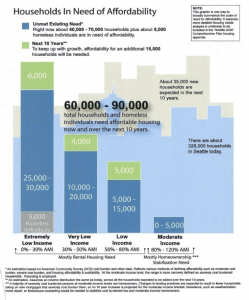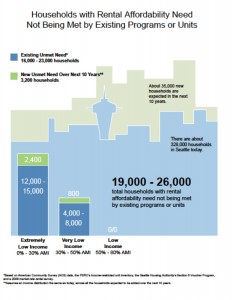Summer Reruns: The Wheels on the Horse Go ‘Round and ‘Round: The Council Passes MHA
I’m taking a break. And so the blog here is in reruns. Back when there was television, Johnny Carson would sometimes turn over his desk to a guest host. Other times they would run reruns as, “The Best of Carson.” So this is The Best of Seattle For Growth.” I decided this week to go with three posts about Mandatory Housing Affordability (MHA), perhaps the single worst housing policy ever conceived by human beings, best summed up as, “housing is expensive, let’s tax it, raise its price, and then build a few lower rent units, somewhere, a long time from now.” This post, about the final passage of MHA, posted earlier this year.
I suppose I should have been emotionally prepared for the final passage of the City’s version of Mandatory Inclusionary Zoning, something they call Mandatory Housing Affordability (MHA). It is sad. But it’s passage seems like nothing more than reading the final punctuation on a municipal suicide note after the deed has been done; there is not much left to do but prepare for the aftermath. Monday afternoon, unanimously, and with much self-congratulation, the Seattle City Council decided to tax all new housing development in the city for the purpose of generating money for non-profit housing developers. As a bit of therapy I’ve been reviewing one of my favorite and most relevant passages of the Aeneid: the taking in of the wooden horse into the walls of the city of Troy. In the story of the wooden horse is the lesson we must take from the whole MHA debacle.
If you’re not into extended allusions to old western classics now is the time to stop reading. And I’ve written on this theme before.
The story of the Trojan horse is one most people know. After a long and protracted but indecisive war between Greeks and Trojans, the Greeks hatch a plan to hide inside a big wooden horse, get taken into the heart of the city, and then ambush the Trojans. I see it as a classic urban tale. The Greek telling of the story in the Odyssey is much less elaborate than in its telling in Latin by Virgil. And there are differences worth noting in the Greek and Latin versions of the story about one of my absolute favorite parts of exactly how the Trojans get the horse filled with Greeks bent on the destruction of Troy into their city, the wheels put under the horses legs.
In the Greek take, Epeius a great architect includes the wheels as part of the construction of the horse.
In the Taking of Ilios by Tryphiodorus, the author includes a fabulous and detailed description of the horse and drama of the Greeks climbing inside with “Epeius of glorious craft” being the last one to board the machine and Odysseus closing the hatch. And the final detail added to the horse by Epeius was the wheels.
And when he had wrought all the warlike horse, he set a well-spoked wheel under each of its feet that when dragged over the plain it might be obedient to the rein, and not travel a difficult path under stress of hands.
Quintus Smyrnaeus in Book XII of his The Fall of Troy details the inspiration of the seer Chalchus to build a wooden horse and the divine inspiration of Epeius (say, eee pie us) in a dream in which Athena promises she “would labour in his labour, and herself stand by his side,” as he designed and built it. When the time came, and the horse was left at the gates of Troy,
Then gathered all,
And o’er that huge Horse hastily cast a rope,
And made it fast above; for under its feet
Smooth wooden rollers had Epeius laid,
That, dragged by Trojan hands, it might glide on
Into their fortress
Homer’s Odyssey doesn’t get into the design in such detail nor does it mention the wheels, but it has a different take on where the council sat down and debated what to do with the horse.
For the Trojans themselves had drawn the horse into their fortress, and it stood there while they sat in council round it, and were in three minds as to what they should do. Some were for breaking it up then and there; others would have it dragged to the top of the rock on which the fortress stood, and then thrown down the precipice; while yet others were for letting it remain as an offering and propitiation for the gods. And this was how they settled it in the end, for the city was doomed when it took in that horse, within which were all the bravest of the Argives waiting to bring death and destruction on the Trojans.
Homer has the Trojans discovering the horse and dragging it in and then having a big debate about what to do with it, a much different take from his colleagues and certainly from the Roman take. For Homer, the death of Hector was the decisive moment of the Trojan War in any event; the wooden horse was sort of the final doom.
Virgil, writing for the Roman Emperor Augustus, was spinning an origin story. The main character of the Aeneid, Aeneas, is one of the last survivors of Troy and he sets out with the household gods gathered from the city’s temples to found a new Troy, what eventually becomes Rome. Augustus is referenced a few times in prophecies but doesn’t feature as much as a Roman emperor might like. Along the way, Aeneas tells the sad story of the horse, and a key difference is what matters most to me,
A spacious breach is made; the town lies bare;
Some hoisting-levers, some the wheels prepare
And fasten to the horse’s feet; the rest
With cables haul along th’ unwieldly beast.
Each on his fellow for assistance calls;
At length the fatal fabric mounts the walls,
Big with destruction.
The pain and agony of the telling of the story when its told by Aeneas is the many warnings they received (at least 3) to not take the horse inside the gates and the struggle they had getting it in. This is not trivial. Imagine being in a car wreck you could have easily avoided by staying home, but forgetting the keys, going back inside, getting them, then forgetting your phone and going back again. You can see the point; it didn’t have to happen.
What’s worse, and to me the symbol of the folly of Troy, is the absence in the Aeneid of Epeius’ wheels. There’s the horse just kind of sunk into the sand. It’s big and its heavy and its full of Greeks. The most sensible and easiest thing to do would be to leave the damn horse there. And once Laocoon hurls his spear into its side, proves that it is hollow and everyone hears the noise from the Greeks from within, you’d think that would have been the prevailing wisdom.
No. Let’s all get together, make a big hole in the city’s walls and build some wheels for this baby.
In his, Virgil’s Aeneid: Decorum, Allusion, and Ideology, Wendell V. Clausen digs into the Latin to draw out both the tragedy and horror of the wheeled horse. In a later translation (Williams, 1910) Aeneas recalls that,
Yet frantic pressed we on, our hearts all blind,
And in the consecrated citadel
Set up the hateful thing.
“Hateful thing” is elsewhere translated as “ill-omened thing” from the Latin, “monstrum infelix.” Claussen writes about that word, “monstrum” in the context of the phrase, “pedibusque rotarum subiciunt lapsus,” which from reading about this and my own weak Latin is essentially, “Smooth-gliding wheels were put under its feet.” But the notion of a horse with wheels instead of feet made it like seem like something closer to our own word “monster,” something violating the rules of nature. Clausen’s take invites us to think of the horse in the way we’d understand how Godzilla functions in our own time, the product of ill advised nuclear testing, horrible, unnatural, destructive and representing the dark side of scientific innovation – and our own doing.
Like the leaders of Troy, the Seattle City Council has been warned again and again that adding costs to the production of housing will not spur its production. Instead, adding additional costs in the form of fees will mean a slow down in production with many projects going on hold. And how will production ramp up again? When prices and rents go up enough to pay for fees we’ll see production levels rise and projects that were shelved go into production. Angry neighbors opposed the Council because they were upset about the modest (the Council’s term) increases in density. And they’ve been warned of the legal jeopardy created by the programs violation of the plain language in RCW 82.02.020 that doesn’t allow oxymoronic mandatory incentive programs.
And the whole proposal is built on a problem defined 5 years ago and with a solution, a few units of expensive subsidized housing, 5 years from now. As I said when I was on the radio not long ago, the actual costs of the 6000 units promised by the program is more like $1.95 billion, not the $472 million in fees the Council claims are forthcoming from the program. And, based on their own numbers, the fees will add as much as $15,000 per unit to the production of market rate housing. I’m not even going to bother to link to the data behind this because what difference does it make now, something to think about when considering that the Seattle Times only covered the issue of what fee money will buy just a week ago.
So its almost like I am there, in Asia Minor on a beach, feeling the sun burning my forehead. I can feel the sand between my toes. I can see a huge horse there sinking into the sand. There’s Sinon, the young Greek spy being quizzed by the Seattle City Council. There’s the spear hurled by Laocoon. I can hear Cassandra’s screaming, as she is lead away. And like a dream, I run toward the growing crown under the shadow of the horse, but I can’t move. I see the crowd approaching with flowers and a strong cable, and, yes, a beautiful set of wheels.
Aeneas had the advantage of watching the city he loved burn to the ground. When he arrived in Carthage and Dido fell in love with him for his suffering the whole world knew of the folly of the wooden horse, the fall of Troy, and even the Gods were watching how the story would play out. Seattle won’t burn to the ground with the passage of MHA. We won’t see building permit applications dwindle to nothing.
We’ll see prices rise to absorb fees and to offset the growing burden of regulatory overreach. When prices go up, we’ll here the Council debate what to do, and then we’ll hear them say, “The only answer is to raise the fees to build a few hundred more units of subsidized units years from now!” And they will. And they’ll claim that they’ve solved the problem at least until prices go up again, and the inflation will punish poor people the hardest at least until an economic downturn causes production and demand to slowdown; hardly the fall of Troy.
Nevertheless, the scene, a council of city leaders engaged in a deliberate and strenuous endeavor that most certainly not solve the problem of higher housing prices but ensure that they will always rise when demand goes up, surely is tragic.
Summer Reruns: What Happened, Why Did We Get MHA, and What’s Next?
I’m taking a break. And so the blog here is in reruns. Back when there was television, Johnny Carson would sometimes turn over his desk to a guest host. Other times they would run reruns as, “The Best of Carson.” So this is The Best of Seattle For Growth.” I decided this week to go with three posts about Mandatory Housing Affordability (MHA), perhaps the single worst housing policy ever conceived by human beings, best summed up as, “housing is expensive, let’s tax it, raise its price, and then build a few lower rent units, somewhere, a long time from now.” This post, kind of an epic about how we got stuck with this mess, posted in November of 2018.
Last week the City’s Hearing Examiner removed the last barrier for citywide implementation of the City’s Mandatory Housing Affordability (MHA) scheme by finding against neighborhood groups that had appealed implementation of MHA. Neighborhood groups argued that the City failed to properly review and consider the impacts of MHA. They failed to persuade, so now the City Council can impose the fees everywhere unless a legal challenge is mounted. At this point, it’s worth looking at how we got to MHA in the first place and what might be next (read a short and concise description about, “What’s Wrong with MHA?”)
How did this all start?
All of this started over a decade ago with proposals to expand something called incentive zoning. In the waning days of 2007, a proposal was moving around City Hall that would have expanded the incentive zoning program, something one lawyer at the time called “zoning for sale;” developers would pay a fee for each additional square foot granted by the program and the money would go to non-profit housing developers. At that time I was just finishing up a stint on City Council staff. But even though we never dealt with the issue, it would come back.
For the next seven years, the fees became the central point of contention in debates about land use in downtown and South Lake Union, with non-profits and some politicians wanting higher fees and developers arguing that higher fees would be a disincentive to participating. Mostly, the fight was between those who thought billionaire Paul Allen was getting away with something and needed to make less money (preferably by giving it to non-profits with fees) and others who viewed the growth in South Lake Union as positive.
But the fight over how much to charge was limited to downtown and South Lake Union. Battles over housing in other neighborhoods was mostly about small-lot single-family development, townhouse and apartment construction, and finally, in 2013 microhousing. As the economy heated up, hiring and growth ramped up, so did the rhetoric about “greed” and “ugly buildings.” In those days, affordability was brought up as one of many issues, but the word and concept grew in repetition and volume as prices rose with increasing demand.
By the time I took on running Seattle For Growth full time in 2014, and seven years after the first rounds of discussion on incentive zoning, we’d had a massive recession caused by a housing bubble and a subsequent recovery. In fact, the market was booming and demand pressures were stoking interest in production of all kinds of housing and innovation in creating supply, especially creating smaller, less expensive housing options.
With rising prices and more construction there also came the election of Kshama Sawant, something that seemed very unlikely just the year before. Her election would turn the volume way up on the noise about rising prices and for interventions like rent control. This pressure from the left would begin to drive the discussion, but for most of 2014 the left was focused on minimum wage, and angry neighbors were pushing more limits on housing types and resisting density.
At the end of 2014 the neighbors had completed a rout of housing that had begun in 2011 when the Council, led by Mike O’Brien, killed the idea of retail in low-rise neighborhoods. Set back by modest upzones in Roosevelt but encouraged by the win on retail, the neighbors shouted down reasonable proposals to regulate small-lot housing in single-family neighborhoods and microhousing. I couldn’t get larger developers interested in turning their fire on the Council to stop this. I was told, “it isn’t our issue,” even though many of the employees moving to Seattle were looking for new, small, and cheaper units.
At the end of that year, seemingly frustrated by the logic of our arguments the City Council shifted on incentive zoning. We had always maintained that incentive zoning was no incentive; charging for additional square footage for housing just added risk and expense that discouraged additional building. It was true, only about a third of eligible projects “took” the incentive. Incentive zoning was legal, but it didn’t work. This meant less money for non-profits. Would the Council lower the price for additional density?
When confronted with the reality that the incentive zoning scheme wasn’t working, Councilmember Mike O’Brien proposed a tax on the development of every square foot of new development in the city to shake out cash for non-profits. This scheme was called the “linkage fee” and we called it the “linkage tax.” This rattled larger developers, especially Vulcan, and a group was formed to oppose the linkage tax. A letter from a bunch of land use attorneyswas written warning that a major lawsuit was possible.
The birth of a “crisis”
At this point, with small-lots and microhousing dead, angry neighbors and lefties fresh from wins on minimum wage began to turn their attention on the linkage idea. It’s important to remember that at this point damaging legislation on housing had been opposed but successful. We filed an appeal of legislation proposed by then Councilmember Sally Clark that deliberately reduced the potential for more housing production in Seattle’s low-rise zone. We did this on our own, with no support from larger developers. We failed.
I repeatedly made the case then that the Council had shifted far to the left or that it had at least realized that they could score political points at the expense of “developers” with little consequence. Housing was either viewed as an “impact,” the source of huge, undeserved profits by corporate developers, or both. View blockage, light and air, and tree protection red herrings merged with social justice claims: more new market rate housing makes single-family neighbors feel bad and it also displaces and harms poor people. More housing means higher prices!
One example of how far things had gone is worth remembering. At some point in rationalizing the imposition of fees as high as $10 or $20 a square foot for all new housing and commercial development, the City trotted out figures that we would later successfully dispute but that reassured the Council that the housing problem was insanely huge. The City staff suggested that Seattle needed 60,000 to 90,000 units of affordable housing to address the cost burden of existing households. This inspired a letter from mostly conservative Councilmembers Bagshaw and Rasmussen suggesting that the City needed to build 6,000 to 9,000 units per year for ten years! Where was the money going to come from? We are in a crisis! They said,
To reach 60,000 – 85,000 units, we must increase our supply by over 6,000-8,500 units of affordable housing annually for the next ten years if we are to make room for the people who want to live and work in our community. If we want to extend that period to twenty years, we need 3,000-4000+ units annually to reach our goal. This will require new approaches.
The City’s numbers proved to be bogus. After we pointed out that they didn’t bother to count all the existing set aside units and microhousing they lowered their numbers – back in 2015 – to something more like 26,000 households, a number that is still cited to this day. As I pointed out in a post a while ago,
Someone forgot to remind themselves that, for example, for the period between 2005 and 2012, housing production in Seattle totaled 29,330 units or, 4,190 units per year.


This was the frenzy unfolding in 2015 and over that summer when the Mayor Murray – who had indicated he had no problem imposing a linkage tax – convened something called the Housing Affordability and Livability Agenda (HALA) Committee. The notion at the time was that this group would do what the committee convened on the minimum wage would do, bargain over the linkage tax and come up with some kind of compromise. Advice from people in that process was that the Mayor would lock people in a room, pound his fist on the table, stomp around, and shout and try to force a “solution.”
HALA, the “Grand Bargain,” and a “crisis” becomes a slow motion disaster
Right now might was well be the time to make a reference to the Trojan Horse. How sad for people that have quit reading at this point to miss out! As Barbara Tuchman writes in her essential March of Folly,
Troy falls at last after ten years of futile, indecisive, noble, mean, tricky, bitter, jealous and only occasionally heroic battle. As the culminating instrumentality for the fall, the story brings in the Wooden Horse. The episode of the Horse exemplifies policy pursued contrary to self-interest — in the face of urgent warning and a feasible alternative. Occurring in this earliest chronicle of Western man, it suggests that such pursuit is an old and inherent human habit.
Why would the leaders of Troy believe that the Greeks had grown tired of fighting, had gone home, and left the big hollow wooden horse as an offering for their wrong doing? Because they were exhausted. Tired from defending their city from a relentless siege. Why would anyone agree to an illegal mandate to pay more fees after opposing voluntary fees? People were tired and big developers thought this would be the end. Wheeling the Trojan Horse of mandated fees into the code would end the war, non-profits would be happy with their cash, and life would go on.
Remember, by 2015 the battle over housing had been raging off and on for the better part of a decade. I was personally exhausted even back then. We’d made every rational argument that more housing was good for lower prices, for the environment, for transit, for jobs, for tax revenue, and for people with less money. Each time we were met with stiff and stubborn resistance, sketchy data, and politics: someone needs to be punished. All this arguing took place in committee meetings, council offices, comment sections, and in person. It was ugly even back then.
By now there were two groups that could say they represented developers, the group of larger developers assembled by Vulcan and Seattle For Growth. I was deliberately excluded from the HALA discussions, even though our group represented arguably the people that build most of the housing in the City. But at the time, it seemed to make sense for me to sit it out; it allowed me to either agree with the outcome or oppose it from the outside. I did what I could, sending articles and emails often to the committee.
In the end what emerged was a deal and a myth, a myth as strong as the one described in the Aeneid. The deal that emerged on fees was between large developers in downtown and South Lake Union who would pay into the existing incentive zoning program for additional square feet on existing proposed projects, and then the City would come up with “modest” upzones and charge fees on every square foot of new housing in the city. This was called the “Grand Bargain,” and is frequently and constantly still called to this day, HALA. This is the myth. Vulcan even paid for signs and stickers that say “HALA Yes” and funded a group called Seattle For Everyone to push it.
Most of the interesting ideas in the HALA report were ignored and the Grand Bargain, now called MHA, would come to absorb the attention of the City and staff and everyone else for the next three years. Throughout this time, no sustained discussion was had in the press or media about the numbers behind the proposal. The old 26,000 cost burdened number has never been revised or updated, there’s been no analysis of the costs of producing non-profit housing and how much could be realistically produced with fees and when. That number was uncritically used to rationalize the so-called “Head Tax.” And the story of HALA became about angry neighbors opposed to density and “urbanists” cheerleading the MHA proposal, mostly because of the fact that neighbors opposed it.
Weirdly, a group of people emerged from the HALA discussion who began to relentlessly pick fights with single-family neighbors about upzoning single-family neighborhoods. This happened when the HALA recommendations were mischaracterized in a Danny Westneat column in the Seattle Times as some kind of single-family roll back. It wasn’t. Yet single-family neighbors made a lot of noise and the Mayor said he’d leave single-family alone. Incensed, some lashed out at single-family neighbors as racist. I watched this with wonder; those very neighbors had done most of the damage. Now, with it too late to save small-lot, mircrohousing, and preserve the low-rise zones there was an anti-single-family mob supporting MHA while the angry neighbor mob was opposing it.
The false narrative and the future
Lost in all this too, was any study or response of what MHA would do to housing production. I personally over the years have made pitch after pitch and plea after plea to consider the costs in production of fees that will be very significant. Mostly, I’ve been treated like Agent Mulder in the X Files. I think that this is partially because my story is complicated. Most people have quit reading by now. The story has lots of twists and turns. Developers and builders are busy closing deals and trying to create housing in an environment that has become less and less hospitable to them and their work. The urbanist crowd, the pro-MHA mob with little immediately at stake for themselves, have been cheerleading the density offered by MHA without any regard to whether the proposal will make things worse. And the angry neighbor mob has opposed the density.
Imagine if Sound Transit proposed a charge on some consumer product related to transportation, say fuel, and had a complex geographic fee schedule. Let’s say the fee was supposed to pay for “affordable transit” including more bus service. One can imagine that the debate would focus on the wider issue of transit capacity and need, but it would also zero in on the question, “What will this do to people paying the fee and what does it actually pay for?”
In today’s debate over MHA, nobody asks these questions. The appeal defeated last week was the latest drama in what has been told as a story about angry neighbors opposing the downsides or more housing in their neighborhood and the Council pushing a policy of “upzones for affordable housing.” How much housing? Where? When? How much density? Will developers build under this new scheme? What happens to market rate housing prices?” There is silence on these key questions, silence that is strange for a policy that will have dramatic and far-reaching effects.
What’s next?
With the neighborhood appeal now squashed, the wooden horse of MHA has just leapt its almost final hurdle, through the main gate of the city walls. The City Council has resisted and ignored any discussion of the inflationary effects of adding thousands of dollars in fees to new housing construction. In fact, they want to add morewith impact fees and they’ve shut off any discussion about reducing the costs of producing market rate and non-profit housing. Executive staff has been high handed and arrogant, dismissing with their silence any notion that MHA won’t solve housing prices but simply make them worse.
The fact is that MHA will stall and kill many projects. We have yet to quantify exactly how many and where. It is a difficult task with each project different from the next. But anecdotally, I hear all the time from builders trying to figure out what the new fees would mean and trying to figure out how they’ll absorb fees. Next, projects can and will work but only when price and rents go up to absorb the fees. This is just a fact. There is no money in development of housing except the money from rent or sales price, period. If costs go up, projects don’t happen or consumers have to pay more.
Finally, remember that letter written by all the big shot attorneys in town? Nothing has changed except the calendar and politics. The proposal is still illegal. You can’t make people include rent-restricted housing and then charge them a fine if they don’t do in exchange for permits. It’s against state law for many of the same reasons argued in that letter against linkage taxes. Here’s what that letter said:
RCW 82.02.020 prohibits the City from imposing a tax or fee on development unless that tax or fee is both voluntary and needed to mitigate a direct impact of a speci2c development. A mandatory linkage fee that applies to most development is neither.
Unless the development community can rouse itself and invest in a legal challenge, the wooden horse of MHA will find it’s way into the code where it will be enshrined in the City’s land use code forever as an entitlement, a stream of cash, for a very powerful interest, non-profit housing developers. I will be Cassandra now: if MHA is not aggressively opposed and soon, the fees will likely never go away. Years from now, when speaking of the challenges to building and financing housing, the discussion will be about fees. And the higher the fees, the higher the rents will need to be, and will inspire even more, higher fees.
This will happen. But will anyone listen to Cassandra now?
Yet frantic pressed we on, our hearts all blind,
and in the consecrated citadel
set up the hateful thing. Cassandra then
from heaven-instructed heart our doom foretold;
but doomed to unbelief were Ilium’s sons.
Our hapless nation on its dying day
flung free o’er streets and shrines the votive flowers.
Vergil. Aeneid. 2.234
The leaders of Troy ignored the warnings. But we do have, as Tuchman points out, a “feasible alternative” to the certain destruction of MHA. We can allow more housing of all kinds in all neighborhoods of Seattle for people of all levels of income. Perhaps had Laocoön and Cassandra filed a legal challenge in Superior Court they could have slowed the progress of the wooden horse long enough for the leaders to think twice. Perhaps we’ll have to leave it up to a judge.
Featured image is The Procession of the Trojan Horse into Troy from about 1760, Giovanni Domenico Tiepolo, The National Gallery, London
Summer Reruns: Should People Struggling With Housing Seek Asylum in Seattle?
It is summer time and that means vacations and trips and all that. I’ll be posting some older posts while I take some time off. This week, I am featuring posts with a theme of immigration. I’m not going to wade into the current discussion. These posts will speak for themselves. This one posted earlier this year after President Trump threatened to send asylum seekers to sanctuary cities like Seattle.
I was only a matter of time. Here’s what Mayor Durkan said yesterday, on Facebook, about President Trump’s threat to send asylum seekers to sanctuary cities like Seattle.
If this president wants to send immigrants and refugees to Seattle, we will do what we have always done to welcome individuals.
Mayor Durkan is taunting President Trump, daring him to send more people to Seattle when the city can’t even house people who are already here. I call this out at Forbes.
What scares Seattle residents of all persuasions, those that think that Seattle is dying and those that think more money from the rich will solve the problem, is wondering where exactly will all these “individuals” live? The Mayor presides over an organization that has systematically made it hard for everyone else to live here. Maybe people in Seattle struggling with paying rent, wondering where they’ll sleep tonight, or living with an abusive partner should apply for asylum. Apparently that’s the only way this City will welcome them with open arms.
Summer Reruns: How Does Seattle’s Bad Housing Policy Hurt Rural Immigrants?
It is summer time and that means vacations and trips and all that. I’ll be posting some older posts while I take some time off. This week, I am featuring posts with a theme of immigration. I’m not going to wade into the current discussion. These posts will speak for themselves. This one posted in March of 2018.
When people in the media talk about a housing “crisis” (I still haven’t seen a quantitative definition of what that means) the image conjured up is usually an urban one. Whether it is homelessness or high rents or the lack of so called “workforce housing,” the concentration of the energy on the issues is mostly on cities and especially Seattle. But Seattle’s anti-supply regime of fees, process, rules and restrictions doesn’t just make housing prices higher in Seattle, but it is sucking resources away from the rest of the state that has housing problems too. Take the example of families at the foot of Rattlesnake Ridge in Yakima. Their story illustrates how regulatory overreach and the hegemony of non-profit developers harms vulnerable people in rural Washington.
In a story headlined, “Residents Displaced By Rattlesnake Ridge Landslide Struggle to Find New Homes,” radio reporters Anna King and Esmy Jimenez chronicles the struggles of families that had to move out of the path of a potential landslide in Yakima.
In the Yakima Valley, the supply of vacant rental housing is even lower—around 1 percent.
“It is really hard for anybody to find housing and I don’t care what income you’re talking about,” Yakima Housing Authority Executive Director Lowel Krueger said.
That’s because in Central Washington, the Great Recession pummeled the construction industry and for many years, fewer new homes were built, Krueger said. Many who used to qualify for mortgages don’t anymore, so there is a surplus of people looking for rentals instead of owning their own homes.
There it is: supply not keeping up with demand. Seattle’s vacancy rate is around 3 percent, so the scarcity of housing is worse in rural Washington. And who are these people who are struggling with a crisis of supply?
Many of the low-income residents in the area are agricultural workers. They work seasonally, often earning only the minimum wage. Sometimes, like in the dead of winter, there’s no work at all, and so it’s an even bigger struggle to put together the cash they need for a deposit, and first and last month’s rent.
What makes that problem even worse?
Nearby there’s another complex specifically for farmworkers. Catholic Charities has a total of 800 units spanning from Wenatchee to Yakima to Benton City.
But for every low-income unit they build, four families are already lined up waiting to fill it.
Emergency officials managing the Rattlesnake Ridge landslide reached out to Catholic Charities for help resettling the residents who were displaced, but the nonprofit didn’t have any room.
So most of the residents who were evacuated are still holed up in a hotel in Yakima.
Here’s a sad example of how the sucking of money from resources like the Housing Trust Fund for big, expensive projects like Capitol Hill Housing’s 12th Avenue Arts project ($47 million for 88 units, or $500,000 per unit!) is harming the rest of the state. The lack of market rate housing means more people need and qualify for subsidies. This means there are fewer subsidies and longer lines in Seattle. Prices go up, lines for subsidized units get longer and the non-profits cry for more, and more, and more money. They’re even going to wring cash out of market rate development through Mandatory Inclusionary Zoning (MIZ).
This cycle of exaction from market rate housing to fuel the growing need for subsidies is a self-imposed crisis if anything. If market rate housing could meet the demand without as many rules, prices wouldn’t be so high, and the demand for subsidies would fall; that would free up resources like the State’s Housing Trust Fund for other needs across the state. Instead, the City Council would rather choke the supply of housing with crazy bike parking requirements, make prices worse, then complain there is a crisis and clean out the housing trust fund.
Meanwhile a Farmworker family faces an uncertain future.
Summer Reruns: An Immigrant’s Values and the American Dream
It is summer time and that means vacations and trips and all that. I’ll be posting some older posts while I take some time off. This week, I am featuring posts with a theme of immigration. I’m not going to wade into the current discussion. These posts will speak for themselves. This one was originally posted, January 26, 2015.
When Tien Ha’s family moved to Washington state, he was 13 years old. His father Chu had been a lieutenant in the U.S.-backed South Vietnamese army and then imprisoned as a P.O.W. for seven years. An agreement with the U.S. government granted Chu and his family the right to immigrate legally to the United States.
The family almost didn’t make the move. After being freed, Chu Ha resumed his life. He rose up through the ranks at a corporation in Vietnam that had construction holdings. He learned as much as he could, then went on to own his own thriving design-build firm in Vietnam. But, above all, Chu Ha was a realist. He knew that in a country like Vietnam, his kids wouldn’t have the opportunities he wanted for them. He wanted freedom—for himself, his wife and his brood of six. So with the money he had made in construction, he made the move to the U.S.
|
HACT Construction Company Founded: 2004 Employees: 25 + General Contractors Development Type(s): Apartments, Office Buildings, Hotels and Religious Facilities Number of Projects per Year: 6 |
Throughout Tien’s childhood in Lynnwood, Washington, and all the way through high school, he and his siblings helped his parents make ends meet. His parents worked janitorial jobs, while his siblings toiled at McDonald’s, but everyone worked, even 13 year old Tien helped out. After years of scraping by, his father not only managed to buy a house for the family, but started a new business as a remodeler and handyman for small residential projects with Tien and his brother tagging along to learn the ropes. The die was cast: both brothers went on to attend WSU for construction management.
Right before graduating in 2004 on a visit home, Tien saw an apartment complex with a poorly executed siding job. The next thing he knew, he had talked the project manager into hiring him and his dad, under the auspices of a company they formed on the fly called HACT Construction (Ha, their last name and C and T for their first names Chu and Tien).
Small jobs came, and bigger jobs followed and then, the economy tanked and there were no jobs at all. So Tien worked on building relationships. He knocked on a lot of doors and picked up small jobs. He scraped by, paid his suppliers and subs and built his reputation, even during the worst of times. Like his father before him, Tien has a drive to survive and thrive that we can only marvel at. Thanks to builders like Ha and his family, the American dream is still alive and strong for both his family and for the people living in the homes he builds.
“During the downturn, the little money I made went to pay my suppliers and subs. My father taught me that determination and a good work ethic will pull you through, even in the roughest times.” ~ Tien Ha








